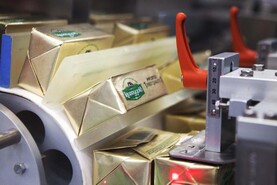Dairy markets will struggle to justify a farmgate milk price in excess of 40c/l this year, a senior Ornua executive has told the Irish Farmers Journal.
Bernard Condon, MD of Ornua’s Global Ingredients Division, warned that dairy markets were “very weak and very thin”.
The Ornua executive said demand should improve during the second and third quarters of the year but maintained that market quotes for butter, cheese and skim milk powder currently equated to a milk price in the “mid-30s”.
“We did our forecasts probably two weeks ago and we were at that stage saying the milk price will be in or around 40c/l for most of the year,” Condon explained.
“I have to say markets have probably weakened since then and certainly if you were to do the sums today the spot return from the market would struggle to get to 40c/l.
“If you were looking at the butter and skim return today and trying to figure out a milk price from that you’d be in the mid- to high-30s, and that’s probably the best foot forward. It would be closer to the mid-30s than to the high-30s if the truth be told.
“But we are expecting that the market will stabilise towards the end of Q2 and we should see a little bit of firming and more stability into Q3,” he predicted.
Dairy spot prices have been on the slide since April last year. Butter has fallen from a high of €7,200/t to €4,750/t, while skim milk powder is back from €4,150/t to €2,400/t.
Describing current market sentiment as “quite bearish”, Condon said reports of increased milk supplies in the northern hemisphere this spring had resulted in buyers “stepping back” in the expectation that commodity prices could fall further.
Although he pointed out that milk supplies this year will broadly return to 2021 levels, Condon said the perception of strong supply growth had negatively affected the market.
“Globally, milk [supply] fell by 0.5% last year and we’re only projecting it to be up by 0.6% this year. So, relatively modest growth,” he explained. “The problem is that year-on-year comparisons, particularly at the moment, look quite big.”
Supplies
While the Ornua executive conceded that milk supplies were currently running ahead of demand, he predicted that markets will strengthen through the summer.
However, he said returns from the market were unlikely to justify an average farmgate price in excess of 40c/l for 2023.
“If the firming that we’re forecasting happens in late Q2 and into Q3, we’d still be hopeful that the market can return that 40c/l on average for the year, but we’re a bit off of it today,” Condon said.
However, he accepted that the hike in input prices remains a concern for farmers, despite the recent easing in the cost of fertiliser, feed and fuel.
Condon described demand for dairy commodities as “reasonable”, but he cautioned that markets were increasingly sensitive to price due to the cost-of-living crisis.
“Chinese demand is decent. There was probably an expectation that when they removed the COVID-19 restrictions that there would be a big increase in demand; unfortunately, we haven’t seen that. But it’s going OK,” he maintained.
“Africa is probably where we’re more nervous from an export perspective. There is an affordability issue for some of our African markets, and I think with the current banking crisis, some of our long-standing customers are finding it difficult to access credit.”
Own-label sales
In terms of retail sales, Condon said markets had been characterised by a “flight to value by the consumer” and a consequent lift in own-label sales.
“We’re seeing certainly on the cheese side more own-label sales, and particularly more own-label sales in the value tier,” he said. “At one stage even own-label butter was over €3 for 250g in Germany and we’ve seen those prices come back closer to €1.70 in the last month or two.”
Condon predicted that “reasonable prices in the market should stimulate demand”.
“We kind of feel that the 40c/l-odd is a reasonable level for the market; it is a level at which there is reasonable demand at retail, food service and export. And hopefully when input prices become more normalised, it is a level perhaps where farmers would be reasonably happy to produce at,” he maintained.






 This is a subscriber-only article
This is a subscriber-only article










SHARING OPTIONS: